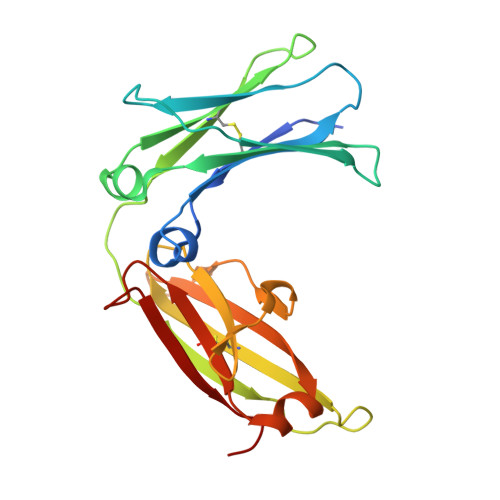An engineered disulfide bond reversibly traps the IgE-Fc3-4 in a closed, nonreceptor binding conformation.
Wurzburg, B.A., Kim, B., Tarchevskaya, S.S., Eggel, A., Vogel, M., Jardetzky, T.S.(2012) J Biological Chem 287: 36251-36257
- PubMed: 22948141
- DOI: https://doi.org/10.1074/jbc.M112.407502
- Primary Citation of Related Structures:
4GT7 - PubMed Abstract:
IgE antibodies interact with the high affinity IgE Fc receptor, FcεRI, and activate inflammatory pathways associated with the allergic response. The IgE-Fc region, comprising the C-terminal domains of the IgE heavy chain, binds FcεRI and can adopt different conformations ranging from a closed form incompatible with receptor binding to an open, receptor-bound state. A number of intermediate states are also observed in different IgE-Fc crystal forms. To further explore this apparent IgE-Fc conformational flexibility and to potentially trap a closed, inactive state, we generated a series of disulfide bond mutants. Here we describe the structure and biochemical properties of an IgE-Fc mutant that is trapped in the closed, non-receptor binding state via an engineered disulfide at residue 335 (Cys-335). Reduction of the disulfide at Cys-335 restores the ability of IgE-Fc to bind to its high affinity receptor, FcεRIα. The structure of the Cys-335 mutant shows that its conformation is within the range of previously observed, closed form IgE-Fc structures and that it retains the hydrophobic pocket found in the hinge region of the closed conformation. Locking the IgE-Fc into the closed state with the Cys-335 mutation does not affect binding of two other IgE-Fc ligands, omalizumab and DARPin E2_79, demonstrating selective blocking of the high affinity receptor binding.
- Department of Structural Biology, Stanford University School of Medicine, Stanford, California 94305, USA.
Organizational Affiliation:


















